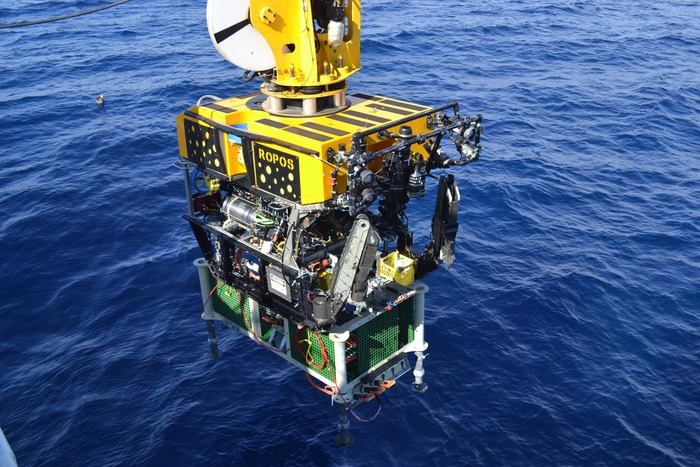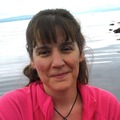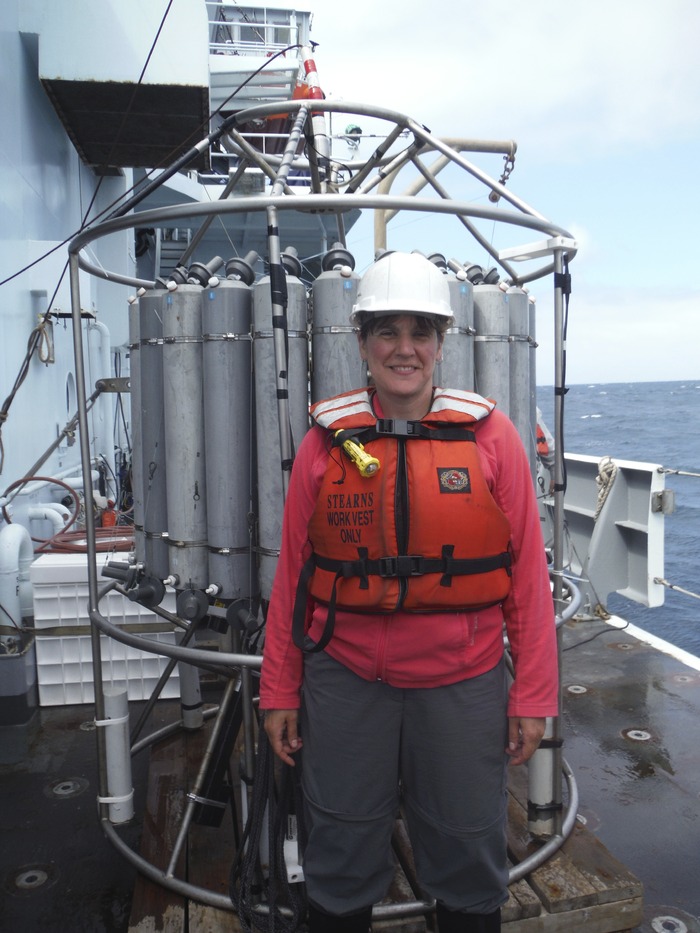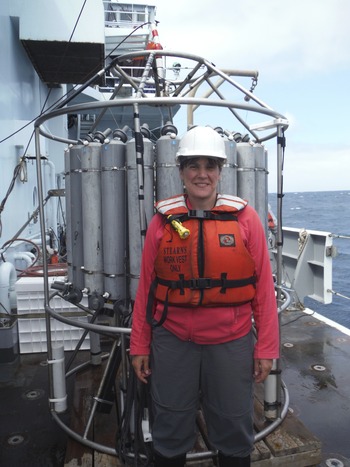Perspectives
I didn’t sleep well last night. My alarm was malfunctioning and I needed to be up for my 4 am watch. After a fitful few hours of sleep, I woke up at 3:30 in a bad mood. A multibeam sonar analysis was in process to identify methane plumes coming from the sea floor and things weren’t quite ready to go with ROPOS yet. Normally, I’d crawl back in bed for another hour or so of sleep. It didn’t seem worth the trouble this morning, though, given my unreliable alarm situation and my unwillingness to ask someone to come wake me up. At some point I wandered out onto the fantail to check out ROPOS and the equipment that was going to be used on this morning’s dive.
“There’s a big whale off the stern!” came the voice and four of us hurried back to try and get a glimpse. The whale surfaced a few times, a bit farther away and then seemed to disappear. The early light of dawn filtered through the clouds as ocean and sky melded into a palette of grey. I walked around to the starboard side of the fantail where a few porpoises were popping into view. Behind me I heard the blowing of the whale and turned to see its massive bulk surfacing again a short distance from the ship. Again I watched it surface, awe-struck. I watched the porpoises dive and surface, dive and surface, again and again. I remembered how, when I swam as a child, I used to pretend I was a dolphin diving into the sea. I watched that pod as long as I could, feeling blessed and grateful for the gift this morning had brought.
ROPOS Operations - July 15
It’s a pretty amazing experience to see live video of the sea floor, from sediments speckled with brittle stars to solidified lava flows (pillow basalts and hackley flows). The occasional ray or skate swims by, sloooowly because of the cold water (about 2 degrees Celsius in this part of the ocean).
The deep ocean is cold, dark and under immense pressure – all reasons we know relatively little about it. Anything sent deep into the ocean has to be able to withstand these conditions. Enter the remotely operated vehicle (ROV). ROVs are commonly used in ocean exploration, both by scientists and industry.
On this expedition, we are using the ROV ROPOS (Remotely Operated Platform for Ocean Sciences). If you have watched any of the live streaming from the Visions website, you are seeing the ocean through the eyes (ok, cameras) of ROPOS. We’ve used ROPOS cameras to survey planned cable routes and examine hydrothermal vent fields.
ROPOS is more than just a window into the ocean. It can pick up and carry heavy loads with it into the ocean, e.g. a tool basket, nodes to be used as part of the cabled observatory, and an apparatus for laying cable (ROCLS – the Remotely Operated Cable Laying System).
Utilizing ROPOS is a coordinated dance between the crew operating it and the ship’s crew. Speed and heading is carefully monitored and there is continual communication between the ROPOS control room and the bridge, especially when operations require movement on the sea floor. It’s all part of the magic of exploring the ocean.

----------------------------------------------------------------------------------------------------------------------------------------------------------------------------------------------
Poetry Break
ocean breeze
waves and ship
undulate
setting sun
gleaming fire
under clouds
crone moon sees
every change
always change
On the R/V Thompson - July 10, 2013
This is my first time at sea, and I can’t say that I had any particular expectations about living on a research vessel for a few weeks. Without a doubt, it is a unique experience. The ship itself has a crew of 21. The Leg 2 science party has 22 scientists, engineers and students, and the ROPOS crew has 9 members. So, if you’re counting, there are 52 people on this 274’ vessel.
Most of us share a room and there is a shared bathroom for every 2 rooms. Showering can be an adventure if the ship is in rough waters. Imagine trying to stay upright while the ship is unpredictably moving beneath your feet. Now throw some soap and water into the mix. Adventure ensues. Some of the best advice I’ve heard is “keep one hand free for the ship.” Imagine trying to carry an armload of stuff up or down a flight of stairs when the ship suddenly rolls. It wouldn’t be pretty.
My stateroom is 1 deck below the main deck and toward the front of the ship. It’s generally a loud place to be, between the waves slapping on the side of the ship and various mechanical devices operating as needed. There is no “quiet time” on the ship. If there is work that needs to be done, it gets done, no matter the time of day. It only makes sense, given the limited time we have to be at sea. It doesn’t take long to get used to the noise.
One thing that has amused me from Day 1 is the number of computers on board. I haven’t counted, but I’m willing to bet that the ratio of computers to humans is greater than 1 to 1. Anyone can send and receive email via the ships wireless network. There are also a few computers with full internet access that anyone can use. (Those who need access for their work with Visions 13 have it as well.)
The hardest working group of people might be the ones who feed us…three meals a day, every day, for all these people. Plus they keep the refrigerators stocked with food and drinks (in case you miss a meal or are up in the middle of the night). They have my eternal respect and thanks for their cooking skills.
CTDs, Rosettes, and Niskin Bottles - July 9, 2013
Last night we did some CTD casts and water sample collection. Anyone who does anything in Oceanography will use a CTD. CTD stands for conductivity, temperature, and depth. These are basic oceanographic measurements, no matter what you study. CTDs can also collect other data (sound velocities, pH and dissolved oxygen concentrations, for example) depending on the instrumentation.
Conductivity is a measurement of the salinity of the water. Temperature and depth are self explanatory, but there are a couple of adjustments that need to be made to those measurements. Depth is determined by taking pressure readings (usually in decibars) and converted to depth in meters.
Temperature readings are affected by pressure. As you get deeper under water, the water is ever so slightly compressed and the temperature increases by about 0.1 degrees Celsius for every 1000 meters. This doesn’t seem like much, but it makes a difference in analysis of water properties. Therefore measured temperature is converted to a temperature unaffected by pressure. This is called potential temperature.
A CTD is attached to the bottom of a frame called a rosette. The rosette also has bottles attached. These Niskin bottles are used to collect water samples. Before the CTD cast, the bottles are opened and set up for remote closure. The entire rosette, with CTD and Niskin bottles, is lowered over the side of the boat with a crane and then continues to be lowered to about 10m about the sea floor. The CTD continuously records data on its way down to the sea floor. The rosette is then slowly raised back to the surface. On its way back up, the apparatus is periodically paused at depths determined by the scientist collecting water samples. One bottle at a time is remotely closed.
When the entire apparatus is safely on board the ship, water from each bottle can be removed for sampling. Some analysis can be done on the ship, depending on the equipment the scientist has brought along. Some analysis is done back in a lab on land.
Notes from 4 am Watch - July 4, 2013
Every student is responsible for a four hour watch so that ROPOS dives can be properly logged. My watch is scheduled from 0400 to 0800.
We are using ROPOS to do a cable route survey. Along this route, cable will be buried under the sea floor (about one meter deep). There needs to be enough sediment to do that without running into bedrock. So far so good.
It is freezing in the ROPOS control room. That does help with staying awake and alert. I am currently wearing leggings under pants, wool socks and hiking boots, a thermal shirt under a fleece jacket under a medium weight jacket. And a wool hat. And I'm still cold. Gloves might have been a good choice to bring, although that would impede my typing skills, which are quite necessary to logging the dive.
I am just sitting, too, which doesn't help with the creation of body heat. I wonder what folks would say if I started doing jumping jacks…probably nothing. This is the little seen, little talked about "sexy" part of science. Or not.
Animals seen today on the bottom of the ocean floor: rays, sunflower stars, rattail fish, sea stars, brittle stars, hagfish, an occasional octopus and sea pigs. Sea pigs look like big sow bugs on the floor of the ocean. Occasionally the ROPOS guys take a pole and shove it into the sediment on the sea floor. By making sure they run into only sediment, confirmation is made that this is a good site to bury the cable.
My watch is over now, so I'm going grab some breakfast and then try to get a bit of sleep.




